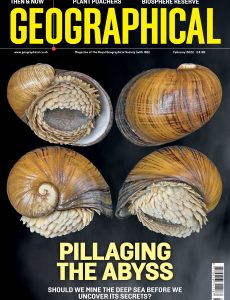
Geographical – February 2022
English | 86 pages | pdf | 82.96 MB
Welcome at Geographical Magazine February 2022 Issue
Our most surprising story this month comes from South Africa, and the peculiar landscape of Knersvlakte Nature Reserve, a huge expanse of quartz gravel, and very little else (page 26). Look closely, however, and you might spot life. The area is particularly well known for the· tiny succulent plants which dot the groun.d, many of them very rare. But, wherever rarity exists, humans are sure to follow. Knersvlakte is facing a poaching epidemic, with large numbers of plants being stolen from the soil for sale to collectors. It’s a far cry from the type of poaching we usually hear about, but is it any less important? As we are constantly reminded, it isn’t just big charismatic animals that deserve protection. I was struck by botanist Carly Cowell’s likening of biodiversity to a brick. wall: remove one brick and the wall might stand, but every removal has a weakening effect and eventually the wall will fall.
It’s a pertinent message for our cover story too (page 36). The striking mollusc on the front of this magazine is colloquially known as the sea pangolin due to
its scaly appearance. It is a remarkable creature for its ability to survive on deep-sea hydrothermal vents, receiving sustenance from bacteria housed within its tissues. It is also the first animal to receive an ‘endangered’ rating on the Red List of Threatened Species due to the future threat of deep-sea mining. Does it matter if the sea pangolin is eradicated in our pursuit of useful metals and minerals? A biologist would say yes, perhaps holding the view that all life has intrinsic value. But a pragmatist might say yes too, pointing out that the sea pangolin is yet one more brick in an already trembling wall. For now, the most common message around deep-sea mining is that we should move slowly- much slower than the current pace. Let the sedate crawl of the sea pangolin serve as a example.
Kati,e Burton
Editor
Download from: